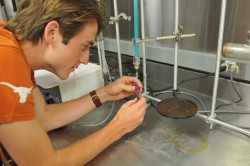Noble Gas Detectives
October 11, 2016

Noble gases in the Earth’s crust can provide information about the origin of dissolved natural gas found in shallow groundwater, and can be used to monitor the performance of a geological storage operation. However, the correct interpretation of the observed noble
gas chemistry requires understanding the behavior of noble gases during subsurface migration.
An interdisciplinary team from the Jackson School of Geosciences looked into this problem with funding from the Center for Subsurface Energy Security (CFSES). In a paper published in Earth and Planetary Science Letters in September 2016, the team brought together field data, laboratory experiments and theory to show that noble gas chemistry patterns are characteristic of gas migration distances and volumes of gas storage reservoirs. Similar to snow piling up in front of a snowplow, migrating noble gases accumulate at the front of a gas plume, and the size of the accumulation
correlates to the distance traveled.
The researchers conducted laboratory experiments that demonstrate these noble gas enrichment patterns and point to field data from naturally-occurring CO2 fields, as well as shale gas plays that show similar patterns.
The study was led by graduate student Kiran Sathaye. Department of Geological Sciences Associate Professor Marc Hesse and researcher Toti Larson also contributed.
Back to the Newsletter